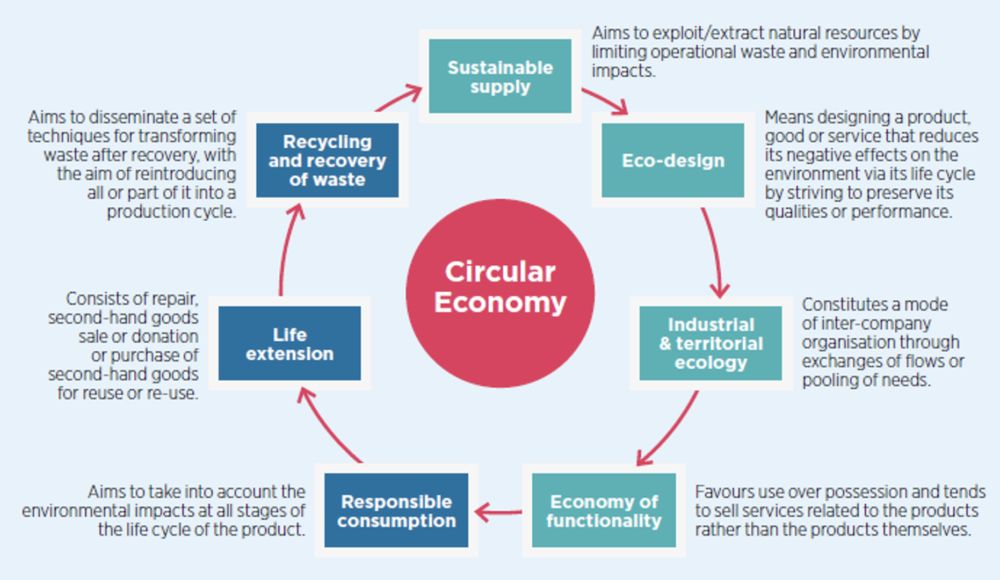There are finite limits to our planet’s natural resources. Intensive exploitation at an increasingly rapid pace prevents nature from regenerating thus contributing to depletion and impoverishment. Our linear economic model, which consists of producing, consuming and throwing away, has a key role leading to devastating impacts on our environment.
Figure 1: Our Economy Favors an Unsustainable Linear Model

The demographic and economic explosion of the 20th century and the advent of mass consumption with cheap and easily replaceable products have put too much pressure on our environment and we are now sounding an alarm. Indeed, this linear economy has overlooked two important points: our natural reserves are limited and nature needs time to regenerate and make new resources available. According to scientific experts, at this pace of extraction, some raw materials will no longer be available in the next 50 year[1] while there will be an increasing demand for energy and natural resources as the world population is expected to reach 9 billion by 2050.
Besides, the linear model of producing more and more and throwing away large amounts of waste, with limited recycling, is in contradiction with the planetary limits. Global waste production was estimated to be 1.3 billion tonnes per year in 2012 vs 2.01 in 2018 (+55%) and is expected to grow to 3.40 billion tonnes by 2050 under a business-as-usual scenario (+160%). As of 2018, it is estimated that globally about 37% of waste is disposed of in some type of landfill, 33% is openly dumped, 19% undergoes materials recovery through recycling and composting and 11% is treated through modern incineration. The consumer society has finally given rise to a society of waste.
Figure 2: Almost 2 Earths were needed to support humanity’s annual resource consumption in 2019

In these circumstances, how can we help companies to move from a linear to a circular model to limit the damage to our environment?
The Rise of the Circular Model
We therefore need to move from a linear economic model to a circular economic model that will limit the damage to the environment, giving it time to regenerate by promoting the extension of the life span of produced goods – notably through eco-design, reparability, durability, and the second-hand market. It must also include better treatment of waste allowing raw materials to be reused to create new goods, thus closing the loop. The circular economy is a solution that has become increasingly successful in recent years: the concept has spread from a small circle of insiders to a growing number of companies and citizens.
However, defining the circular economy is not easy and there is no universal definition today. At Amundi, we consider that the circular economy is a change of economic model that allows producing sustainable consumer goods, while protecting nature – by giving it time to regenerate – and ensuring the well-being of individuals.
This new economic model translates into:
- A better management and use of natural resources
- Goods designed and produced to last
- Consumers who are informed about the environmental impacts of what they buy and who consume sensibly
- A more efficient system for processing end-of-life products from which more secondary raw materials can be obtained.
Each stage of the production of a product or a consumer good must therefore be reviewed in the light of this above definition:
Figure 3: The Circular Economy Proposes a New Economic Model that Re-evaluates each Stage of Production

Investors have a Role to Play
in Promoting a Circular Economy
As investors, promoting a circular economy is an opportunity not only to help decouple environmental degradation from economic growth but also a financial opportunity that drives innovation and competitiveness. Research shows that the circular economy offers a $4.5 trillion economic opportunity by reducing waste, stimulating innovation and creating employment. New business models focused on reuse, repair, remanufacturing and sharing models also offer significant innovation opportunities. However, for these prospects to be realized, companies need to re-think their entire business model and business strategy and this requires investor support. In the short term, there is an interest of companies to perpetuate the linear model as turnover is based on producing and selling at scale. The circular economy, on the other hand, proposes a new model in which the good has been designed to last and in which its longevity is key. This longevity translates again into eco-design, reparability, durability and recyclability and will require a complete redefinition of company strategy (aka a circular makeover). This change is not simple and certainly cannot happen overnight but again investors have a key role to play in supporting and encouraging this circular transition.
Best Practice Recommendations
for Corporates
To encourage circularity, investors have to be armed with best practice recommendations to inspire the right kind of systemic change. However, there is no one circular model, but rather a variety of systems that work together to create a comprehensive circular strategy. This means there is ultimately no ‘one size fits all’ strategy for companies. However, to promote a circular economy across all sectors and companies one thing is key: the concept of circularity must be integrated into company strategy.
Based on our work on the topic and company engagements, at Amundi, we have identified the following recommendations for best practice divided into four main categories:
A Circular Model has to Come
from the Top
Circular economy must be strongly integrated into the core business model of the company. This means circularity is not simply assimilated into general ESG strategy, but that the strategy around circular economy is a distinct topic with strategic CEO and board oversight. Updates on the circular economy strategy should be presented to the board at least once or twice a year.
Translate a Top Down Strategy
into Clear Quantitative Commitments
Companies should establish strong and clear circular economy commitments with objectives and quantitative targets. Many companies are developing targets to increase the recyclability of materials used, but they must also focus on increasing the amount of recycled content used in new products (i.e start viewing second hand products/materials as new resources and not waste). Quantitative targets need to also go beyond material based targets and focus on fully circular product targets. For many sectors, this is great in theory but not practice as it is technically impossible or too expensive to scale. Regardless, these theories will only become a technical reality if companies drive strategies to dedicate resources to solving these problems. Thus, we support quantitative product targets where circular solutions are technically possible and R&D/Capex targets to mobilize resources in areas that need further innovation.
Get all Hands on Deck to Design
and Prepare for a Circular Economy
A true circular strategy needs all hands on deck. This includes internal teams ranging from product developers, purchasing departments, and logistics to sales & marketing. We recommend internal training to empower employees to incorporate circularity principles into their day to day work but also technical training where needed such as to further eco-design in product development or on communicating circularity to customers so they remain involved in the circular process.
In addition, circularity requires collaboration with external stakeholders including suppliers and third party experts. Companies need to ensure that suppliers are seen as partners in this circular revolution. We have observed that strong supplier partnerships with a longstanding core group of supplies helps companies better integrate circularity into their business. For areas where technical innovation is still needed, we encourage companies to work with their peers, circularity experts, and NGOs to collectively address these problems and find solutions.
Think about the End in the Beginning
Finally, at the end of life of products, we encourage companies to think of the end in the beginning (it is a loop after all). Designing for disassembly and raw material recovery is essential to kicking off this circular cycle. To effectively do this, there are a wide range of things to consider including the recyclability and longevity of individual components versus the recyclability of the products overall. Also, consideration is needed for how products and components are collected and how these materials feed back into the original system. This is certainly not an easy task and it will ultimately look different for every material, product, company, and sector. The point is, these discussions need to happen in the beginning, not the end involving the relevant people and teams right from the start.
Conclusion
True circularity is certainly easier in theory than practice but the impact of a linear model means it is no longer a viable strategy. Companies thus need to imagine new ways of doing business and a circular mindset will help companies address these impacts while remaining competitive. Yes, technical challenges exist, but our work at Amundi has shown that the integration of the circular economy by companies has accelerated over the last few years and feasible solutions are beginning to scale. It is ultimately companies that are ambitious in their adoption of circular strategies who are the ones driving change and innovation. Thus, our message to corporations is that the time to act is now.
Sources:
[1] Metal depletion: should we be worried?, Ademe, 2017.
RIA Disclaimer
The views and opinions expressed in this article are solely those of the authors and do not necessarily reflect the view or position of the Responsible Investment Association (RIA). The RIA does not endorse, recommend, or guarantee any of the claims made by the authors. This article is intended as general information and not investment advice. We recommend consulting with a qualified advisor or investment professional prior to making any investment or investment-related decision.


